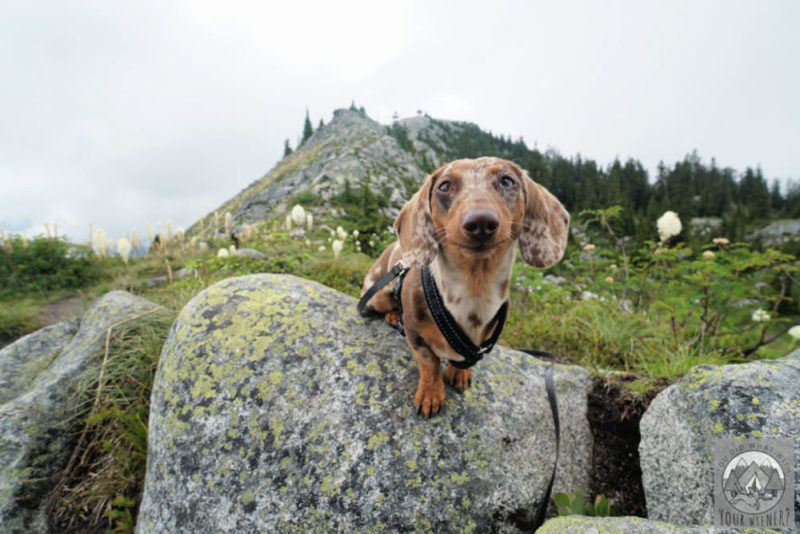9 Beginner Mistakes I Made When Hiking With My Dog
If you are thinking of taking your dog hiking for the first time, you might be a bit nervous.
You want to make sure both you and your dog have a good time and no one gets injured.
Well, I started hiking with my dog 15 years and I made a lot of mistakes.

I consider myself a bit of an expert on hiking with dogs now but I learned what I know through bad experiences, and trial and error, over the years.
In this article, I share some of my biggest mistakes in hopes that you don’t have to learn these things the hard way like I did.
Disclosure: Some of the links in this article are affiliate links (Amazon Associate or other programs we participate in). As an affiliate, I earn a small commission from qualifying purchases.
Big Mistakes I Made When I Started Hiking With My Dog
1) Started hiking when my puppy was too young
Puppies should avoid rigorous exercise while their bones and joints are still developing to avoid orthopedic injuries later.
For small dogs, their bones and joints aren’t fully formed until 10-12 months old.
Larger dogs mature slower so you should wait until they are 18-24 months to start hiking with them.
Luckily, it didn’t hurt my dog but you can bet I was more careful with my next puppy.
For more information Red: How Old Does My Puppy Need to Be Before They Start Hiking
2) Pushed my dog to hard
Some dogs need encouragement when they are new to hiking because they are unsure of their surroundings and their ability.
But there is a fine line between encouragement and pushing beyond limits.
And it’s totally possible for you to miss the signs and signals that your dog has had enough when you have little to no experience doing a lot of rigorous physical activity with them.
Keep an eye out for these signs your dog is too tired to continue hiking and learn how your own own dog likes let you know they have reached their limit.
3) Waited until it was too late to turn around
In the beginning, I waited until my dog looked and acted tired to start back toward the trailhead. But that was too late.
My dog didn’t always make it all the way back before getting too exhausted and refusing to go on.
Luckily, I have a 10 lb dog so I could just carry my pup the rest of the way but this can be a huge issue with big dogs (no pun intended).
If your dog plops down on the trail and refuses to move, you either have the physically difficult task ahead of carrying your dog or you will have to rest and wait until your dog has the energy to keep going.
Don’t be me. Turn around before your dog starts to look and act tired.
4) Didn’t check my dog for potential injuries during the hike
Of course, I naturally noticed when something was wrong with my dog once we returned home but I didn’t usually notice while it was happening on the hike.
Harness chafing, and foot problems like pad scrapes and tears, are common dog hiking injuries.
I’ve gone on a hike for a few miles only to find that my dog’s arm pits were rubbed raw and bleeding a little when we got home.
I didn’t discover there was a foot problem until my dog started to limp (and often, dogs don’t show pain until it’s really bad).
Now I check for these things several times during our hike to help minimize any injury or discomfort.
I bring a second hiking dog harness so I can switch to a different one during the hike if needed.
A harness that fits different enough won’t keep rubbing on the same raw spot.
I also bring extra supplies in my first aid kit to treat my dog for a paw injury if needed (see below for more information on that).
5) Didn’t ensure my dog was drinking enough water
Initially, I assumed that my dog would drink water when they were thirsty and would drink enough to stay sufficiently hydrated.
I was wrong.
Dogs often won’t drink water when they are stressed and this includes both good and bad stress.
Your dog may not drink water when they should for many reasons including:
- They’re over stimulated
- They’re too distracted
- They’re too tired
- They’re too nervous
- Their in pain or experiencing discomfort
My remedy for this is to bring water flavored with bone broth for dogs, add a flavored dog electrolyte mix to the water, or entice my dog to drink by throwing treats into the water bowl.
6) Didn’t carry any dog specific stuff in my first aid kit
While it’s true that some of what is in a human first aid kit can be used on dogs – like alcohol swabs, tape (definitely not a great idea because it can stick to fur and pull it but it works in a pinch), and bandages, not all of it can.
I learned that I needed to supplement my first aid kit with items that were specific to my dog’s needs.
Dog foot and paw pad injuries are one of the most common trail first aid issues and those can be difficult to bandage.
At a minimum, I bring nail clippers or small scissors to cut torn pads, vet wrap, gauze bandages, and PawFlex Medimitt Paw Bandages (with PawFlex Outdoor Water Proof Cover or Paws dog boots to help keep the bandage dry).
7) Didn’t have an emergency plan
What if your dog is injured and can’t walk? What is your emergency evacuation plan?
Do you just assume you can just carry your dog? I did.
I guarantee you that even small dogs get heavy real fast.
With some larger dogs, it’s impossible for one person alone to carry them and it’s very difficult for two.
You may want to get a dog emergency evacuation sling for hiking if you have a larger dog.
For my small dog, I just bring a REI Flash 18 pack I can wear on the front like a kangaroo pouch.
It’s also important to think about what you would do with your dog if another person in your party gets injured.
If you have to run for help, can your dog keep up with you or stay with the injured party or another hiker?
What if you have to stay out overnight? Did you bring enough food and supplies for your dog to survive a night in the cold?
8) Not putting tick protection on
For most of my dog’s life, we lived where encountering ticks was rare.
However, we didn’t hike where we lived and there were a lot of ticks on many of the trails.
I just didn’t think about it but my dog could have been bitten by a tick and picked up some kind of disease.
Now I use a monthly topical – my favorite is Vectra 3D – during tick season.
Often topical tick treatments also protect from other bugs and disease vectors too like mosquitoes, and thus heartworm, and mites.
9) Relying on the hope and prayer method for dangerous wildlife
I just hoped my dog and I wouldn’t run into wildlife that may want to harm us on the trail and I prayed I would be able to scare them off if we did.
But different wildlife require different approaches.
For example, what works for Grizzly Bears is the opposite of what you want to do with Black Bears.
Be sure to know what types of (potentially) dangerous wild animals you might encounter and how to scare off, and protect yourself and your dog, from wildlife.
Hopefully you feel more confident and prepared to hike with your dog for the first time now.


About the Author
Hi, I’m Jessica. I’ve been studying the Dachshund breed since 2007, owned 3 of my own, and shared in the lives of thousands of others through their owner’s stories. When I’m not sharing what I know on this blog, you can find me hiking, camping, and traveling with my adventurous wiener dogs.

Jessica –
Thank you for sharing your mistakes so we can learn from them! I have been mulling how I would ever pack out our 35# or 45# border collies in case of a hiking disaster, so appreciate that link.
And I second the wildlife awareness part. We freely hike in areas that have black bear, coyote, wolf, bobcat and mountain lion. We are always alert to our surroundings, an haven’t had any issues. But a small dog was snatched and killed by a coyote just this week, on a trail in the foothills just outside Boise. Presumably the coyote was protecting a den (there were signs posted about aggressive coyote behavior in that area); nonetheless, what a tragedy for the dog’s owner.
Frankly, I’m more worried about tick-borne diseases, so we too use tick preventatives. Another issue i many parts of the country is leptospirosis, which dogs can pick up from drinking from contaminated puddles. So keep those vaccinations up to date if you’re in ‘lepto country’.
Thanks again for the good advice.
That’s sad about the dog. We have similar wildlife risks here. Washington does have leptospirosis but Dachshund are notorious for having bad reactions from excessive swelling to hospitalization so I haven’t’ done it yet. I know it’s a risk we are taking though (a friend’s dog contracted it in their back yard and died so I know how bad it can be),
When me and my dog went hiking I definitely forgot to make sure he was well hydrated. He ended up becoming dehydrated during our hike and I had to rush him to the vet. Thankfully they told me what was wrong because I didn’t even know he was dehydrated. I wish I would have found this article BEFORE we went hiking. But I’m glad he’s ok!
Glad everything turned out ok in the end for your pup. At least you know now.
Thank you so much for sharing your experiences! I definitely made a few of those mistakes today 😬
I will make the necessary changes!!
Taking notes – thank you so much for sharing your experience! Planning to hike with my dog soon as well.